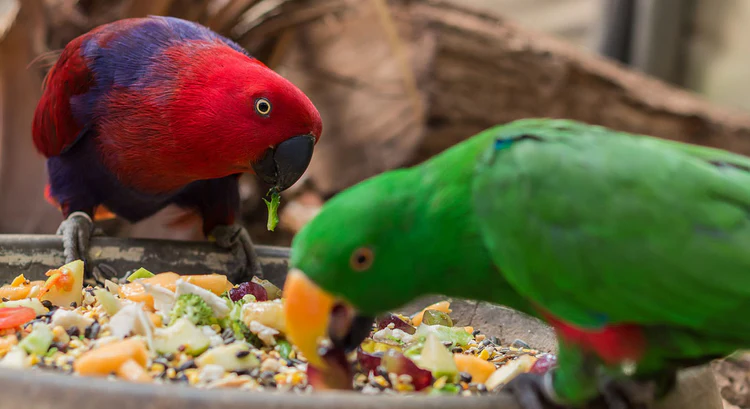Feeding a bird may seem straightforward—just toss in some seeds, right? Not quite.
In fact, one of the most common causes of illness in pet birds is poor nutrition. Unlike cats or dogs, birds have very specific dietary needs, and feeding them an imbalanced diet can lead to serious health problems over time, including obesity, feather plucking, organ failure, and even early death.
Whether you’re caring for a tiny budgie or a majestic African Grey, understanding what goes into a healthy avian diet is essential. In this article, we’ll break down the differences between pellets and seeds, talk about the importance of fresh foods, and share tips on how to prevent nutritional deficiencies.
Seeds vs. Pellets: The Great Debate
For decades, seeds were the standard bird food—and many stores still sell “parrot seed mixes” as the default. But over the years, avian vets and researchers have discovered that a seed-only diet is not only incomplete—it’s harmful.
Seed Diets:
- High in fat, especially sunflower and safflower seeds
- Low in essential vitamins (like A and D) and minerals (like calcium)
- Can lead to obesity, fatty liver disease, and vitamin A deficiency
- Birds tend to pick out favorite seeds, ignoring others
While seeds can be part of a healthy diet in moderation, they shouldn’t make up the bulk of your bird’s daily intake. Think of them as treats or occasional supplements, not the main course.
Pellet Diets:
- Formulated to be nutritionally complete
- Lower in fat, with added vitamins and minerals
- Prevent selective eating—every bite has the same nutrients
- Widely recommended by avian veterinarians
Pellets come in different sizes and formulas depending on species. Brands like Harrison’s, Roudybush, and Zupreem are commonly recommended. Just be sure to choose organic or low-sugar versions when possible—some flavored pellets contain added dyes or sweeteners, which aren’t ideal.
Transitioning from Seeds to Pellets: A Patient Process
Many birds raised on seed diets are resistant to switching—especially parrots, who can be stubborn and suspicious of new foods. Transitioning takes time, consistency, and creativity.
Tips for switching:
- Mix a small amount of pellets into their regular food and gradually increase over time
- Try offering pellets first thing in the morning, when your bird is most hungry
- Soften pellets with a bit of warm water to enhance aroma and texture
- Offer pellets by hand or as part of a game to encourage curiosity
It’s crucial not to starve your bird into eating pellets. Monitor food intake closely and consult your avian vet if you’re concerned about weight loss during the transition.
Fresh Fruits, Vegetables, and Grains: Essential Daily Additions
Even a pellet-based diet isn’t enough on its own. Birds thrive on variety, and adding fresh foods is key to mental stimulation and overall health.
Vegetables:
Dark leafy greens like kale, dandelion, collard greens, and spinach are rich in calcium and Vitamin A. Carrots, bell peppers, sweet potato, and broccoli are also excellent choices. Offer a rainbow of colors to provide a range of nutrients.
Fruits:
In moderation, fruits provide vitamins and hydration. Apples (no seeds), bananas, berries, mango, and melon are all bird-safe. Avoid high-sugar fruits as a daily staple.
Grains and Legumes:
Cooked brown rice, quinoa, lentils, and chickpeas can be added to your bird’s bowl a few times a week. These provide protein, fiber, and essential nutrients.
Avoid these toxic foods:
- Avocado
- Chocolate
- Caffeine
- Alcohol
- Onion and garlic
- Apple seeds and cherry pits
Always wash produce thoroughly and remove uneaten fresh food after a few hours to prevent spoilage or mold.
Nutritional Deficiencies: Silent but Dangerous
Birds are excellent at hiding illness—so nutritional problems often go unnoticed until it’s too late. Some common deficiencies include:
- Vitamin A deficiency: leads to respiratory infections, poor feather condition, and skin problems
- Calcium deficiency: especially common in egg-laying females; can result in weak bones, seizures, or egg-binding
- Protein deficiency: leads to feather loss, fatigue, and poor immune function
Signs of nutritional imbalance:
- Dull, frayed, or missing feathers
- Changes in droppings (color, consistency, or volume)
- Lethargy or lack of interest in play
- Beak or nail overgrowth
- Weight loss or gain
Regular check-ups with an avian veterinarian can catch these issues early. Blood panels, weight tracking, and beak/nail exams help ensure your bird is staying healthy on their current diet.
Hydration: Don’t Forget Water
Fresh water should always be available. Birds can be sensitive to chemicals in tap water, so using filtered or bottled water is often safer. Change water daily—and more often if soiled with food or droppings.
Some birds also enjoy bathing or misting. Clean feathers help with insulation and comfort, and regular bathing supports skin health.
A Healthy Diet is a Lifelong Commitment
Feeding your bird isn’t just a daily chore—it’s an act of care and respect for their complex biology. A balanced diet supports longevity, reduces vet bills, and improves behavior and mood.
By understanding the pros and cons of seeds and pellets, incorporating fresh and varied foods, and watching for signs of deficiency, you can help your feathered friend live a long, vibrant life.
Start small, be consistent, and don’t hesitate to get professional guidance. Your bird may not thank you with words—but they’ll show it in their energy, playfulness, and brilliant plumage.

